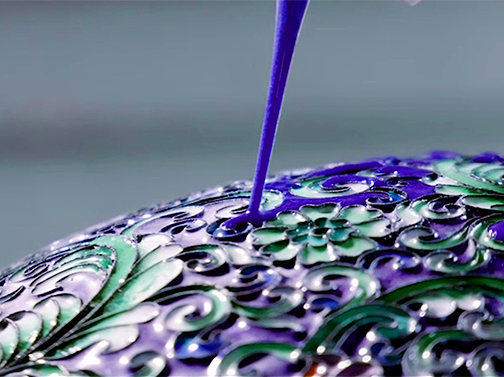Cloisonne culture cloisonne, historically known as enamel, technically known as bronze tire enamel. During the period of Jingtai in Ming Dynasty (1450-1457), this technology has been very mature, especially the new breakthrough of blue glaze, such as sapphire-rich sapphire, noble and beautiful, so it is called Jingtai Blue. This ancient artistic treasure has developed to modern times. Although Cloisonne works have various colors, they still follow the customary title of cloisonne. Cloisonne's manufacturing process is to first use copper tire, then roll flat with fine copper wire, then break into various patterns by hand, first pinch, then weld, so that it firmly adheres to the copper matrix, coupled with various colors of enamel glaze, after firing, polishing, gold plating and other processes, can finally be completed. Cloisonne's craftsmanship not only uses the traditional techniques of bronze and porcelain firing, but also absorbs the traditional techniques of painting and sculpture. The craftsmanship made of cloisonne has the artistic characteristics of vigor, dignity and elegance.


As for the origin of cloisonne, due to insufficient historical documents and the lack of manufactured products with reliable years as a basis for dating, experts and scholars have different opinions, and it is still difficult to conclude. At present, there are two most concentrated views. Cloisonne technology originated in China. As early as the Spring and Autumn Period, enamel glaze was embedded on the sword handle of Goujian sword of Yue King; the Han Dynasty copper pot unearthed in Mancheng was also decorated with enamel on the pot body; the Tang Dynasty bronze mirror hidden in Zhengcang Courtyard of Japan was decorated with various colors of enamel on the back of the mirror. In Chinese metal technology, enamel has a long history of application, but for various reasons, this process did not continue to develop, until the Ming Dynasty, it ushered in a prosperous period. Secondly, the emergence of cloisonne technology in China began in the Yuan Dynasty. During Kublai Khan's Western Expedition, this craft was introduced to China from the Arab region of West Asia. It first became popular in Yunnan for a generation. Later, it was loved by the people of Beijing and was introduced to the Central Plains.
According to "New Ge Guyao on Ancient Kiln Wares on Big Food Kiln", it is recorded that Big Food Kiln originated from Big Food Country. It is similar to Franc's inlay that the body is made of copper and the flowers are burned with medicine. Taste incense burners, vases, boxes, calves and so on, but in the women's boudoir, non-scholar literary study playful. The world is also known as the Ghost Kiln. Nowadays Yunnan people often make wine in Beijing. It is commonly called Ghost Kiln. The author of the inner government is warm and lovely. Ancient craftsmen in our country quickly mastered the production technology of the big food kiln, and combined with the traditional craftsmanship of our country, after several improvements, produced a brand-new metal tire Enamel Cloisonne with national characteristics. At this time, there are more than a dozen translated names of enamel, such as Folin, Franc, Hailan and so on.


These two views differ greatly about the origin of cloisonne craft, but one of them is the same: this craft did not start in the Ming Dynasty, but its historical origin can be traced back to the Yuan Dynasty or even more ancient times. In addition, the academia also acknowledges that Cloisonne can achieve great artistic achievements in a short period of time. The main reason is that at the end of Yuan Dynasty and the beginning of Ming Dynasty, China has already possessed mature metallurgical technologies such as copper casting, glass and glaze production techniques, and mastered the control of calcination temperature, which created good conditions for the development of cloisonne technology. In the Ming and Qing dynasties, Cloisonne technology has been greatly developed and has become a wonderful flower in the field of traditional Chinese arts and crafts.